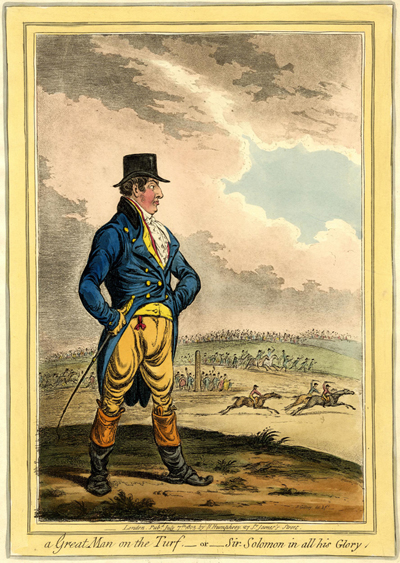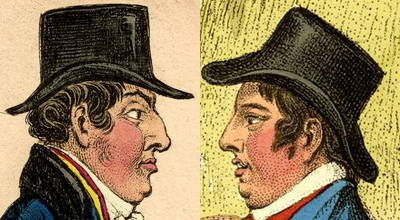A Great Man on the Turf, or
Sir Solomon in All His Glory
Thomas Wright and R.H. Evans identify the man in this portrait caricature as the Duke of Bedford. And with some reason. Francis Russell, the 5th Duke of Bedford was indeed "A Great Man on the Turf," the owner and breeder of race horses at his country house at Woburn Abbey, and frequently portrayed by Gillray in prints like The Affrighted Centaur, and Doublûres of Characters, with a jockey's cap and jacket, or, as in The Loyal Toast, wearing riding boots and spurs. And the dark-haired man portrayed here looks a lot like the many caricatured portraits of the 5th Duke created by Gillray in 1798 and 1799.

© Trustees of the British Museum
But there are several problems with this identification. One is that the Duke of Bedford had died suddenly in March of 1802, more than a year before the publication of this print. It would be highly unusual for Gillray (or anyone else) to create a portrait caricature of a dead man. Second, there are differences between the 5th Duke and the man portrayed here—differences, particularly in the nose and mouth. And the most recent portrayal of the Duke by Gillray, Fat Cattle in February of 1802, had shown a much more obese man than the one portrayed here.

© Trustees of the British Museum
Finally, there is the reference to "Sir Solomon," a famous race horse of the time. Portrait caricatures typically provide a clue, often in the title, to the identity of the subject. So if this man is the Duke of Bedford, we would expect to find that Sir Solomon was a racehorse affiliated with the Duke or, more likely, a product of his stables at Woburn Abbey. But this is not the case. Sir Solomon was never owned by Bedford, but rather by a competitor breeder, Mr. J. Johnson according to the London Times, September 23, 1801,Pg. 2.
Mr. Johnson, the owner of Sir Solomon, is a Gentleman of large fortune in the North, who never comes to London, but keeps fine racers, and is deemed a good judge.
The most comprehensive account of Sir Solomon can be found in Thoroughbred Heritage, a database of English and American race horses which confirms the ownership by Johnson. Originally named Tankersley, the future Sir Solomon ran
between 1799 and 1802. Did not win in four races at 3, was sold to J. Johnson and renamed Sir Solomon. At 4, won the King's Plate at Nottingham and also at York, and one other race out of 7. In 1801 he hit his stride, winning all but one race, his successful 4 mile match against Cockfighter, in which he was never headed, at Doncaster, long-remembered. In 1802 he won four races, including the Newcastle Cup and the Newmarket Great Subscription Stakes. Sold to Lumley Savile at the end of the season, and retired to the Savile stud.
As the summary above suggests, the "glory" years of Sir Solomon were behind him when this print was published in July of 1803, so the scene with its Great Man and his horse seems more like a commemoration or tribute than anything else. The most likely identification for the Great Man, then, would be the owner of Sir Solomon in his heyday, Mr. J. Johnson the "Gentleman of large fortune in the North." And since there is no indication of satire here, the print may have been commisioned by the Great Man himself.
Sources and Reading
- Commentary from the British Museum on A Great Man on the Turf, or Sir Solomon in All His Glory.
- "Horse Racing in Great Britain" Wikipedia
- "Race between Cockfighter and Sir Solomon," The Sporting Magazine September 1801
- Thomas Wright and R.H. Evans, Historical and Descriptive Account of the Caricatures of James Gillray #524.
- Thomas Wright and Joseph Grego, The Works of James Gillray, the Caricaturist; With the History of His Life and Times, p. 308.
Comments & Corrections
NOTE: Comments and/or corrections are always appreciated. To make that easier, I have included a form below that you can use. I promise never to share any of the info provided without your express permission.